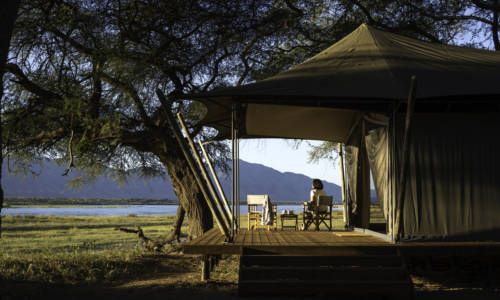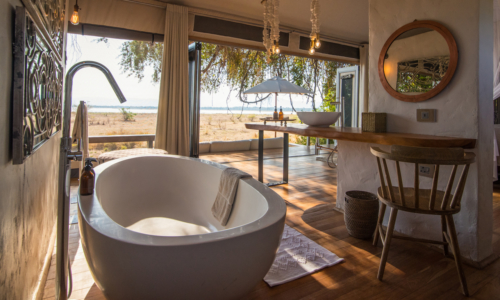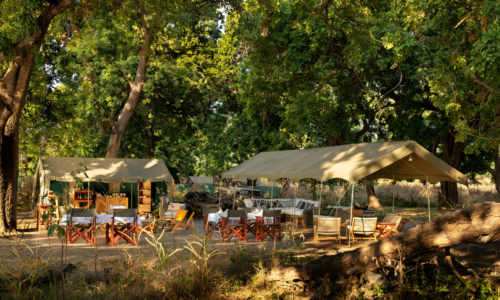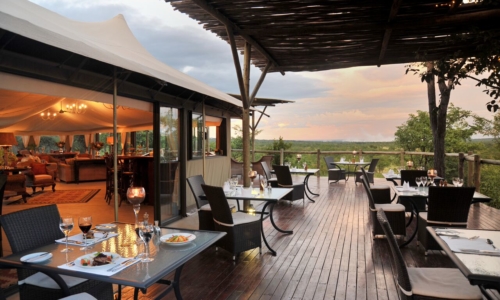Set aside as a national park in 1929, Hwange National Park, pronounced ‘Wang-ee’, was named after a local Nhanzwa chief and was once the royal hunting grounds to the Ndebele warrior-king Mzilikazi in the early 19th Century. It encompasses 5,657-sqaure miles and is one of the ten largest parks in Africa. The park’s landscapes are varied, ranging from desert sands to sparse mopane woodland to grassland to vast slabs of hard granite rock. The western edge of the park borders the Kalahari Desert, while the park’s southern end supports immense forests. Manmade waterholes are scattered throughout the park as a means of providing water to the animals throughout the dry season. Unfortunately, some poaching incidents and the death of Cecil the Lion has given the park some bad press. But Hwange has been working hard to protect its wildlife including two important conservation and research projects: The National Leopard Project and the Painted Dog Project.
Being such a large park, there is an abundance of animals to be spotted here. In fact, Hwange has 107 types of wildlife living here including lion, buffalo, cheetah leopard, spotted hyena, cheetah, giraffe, sable, roan, blue wildebeest, impala, waterbuck, and reedbuck. But what the park is famous for is its elephants. Hwange is home to some 40,000 elephants, boasting one of the world’s largest populations of pachyderms. In addition to which, the population of Cape wild dogs is believed to be the largest surviving group in Africa.
Hwange National Park is also one of the few places where gemsbok and brown hyenas can be found. Moreover, the park is also a bird watcher’s paradise with 400 different bird species being recorded here. The best time for wildlife viewing is from July to October, when animals congregate around the sixty water holes or ‘pans’, most of which are artificially filled.
There are plenty of exciting activities to enjoy within the park. The local safari lodges and camps offer game drives conducted in open Land Rovers by expert guides and trackers. Morning walking safaris led by a knowledgeable guide are the best way to see the landscape in detail and view any smaller flora or fauna missed by the vehicles. Night drives discover the nocturnal world of lesser bush baby, spotted hyena, leopard, lion, Selous mongoose, pangolin, caracal, porcupine, scrub hare, springhare, and even honey badger. Horseback safaris are a fun and unique way of discovering Hwange. While, cultural visits travel to the local villages to learn about their culture and traditions.


- Amalinda Lodge
- Bumi Hills Safari Lodge
- Camp Hwange
- Changa Safari Camp
- Chikwenya
- Davison’s Camp
- Deteema Springs
- Ingwe Pan
- Kanga Expeditions
- Linkwasha Camp
- Little Makalolo
- Little Ruckomechi
- Little Vundu
- Mana River Camp
- Matetsi Victoria Falls
- Mpala Jena Camp
- Muddy Teak
- Nyamatusi Camp
- Nyamatusi Mahogany
- Old Drift Lodge
- Pamushana Lodge
- Ruckomechi Camp
- Somalisa Acacia
- Somalisa Camp
- Somalisa Expeditions
- Tembo Plains
- The Elephant Camp
- The Hide
- Verney’s Camp
- Vundu Camp
- Zambezi Expeditions
- Amalinda Lodge
- Bumi Hills Safari Lodge
- Camp Hwange
- Changa Safari Camp
- Chikwenya
- Davison’s Camp
- Deteema Springs
- Ingwe Pan
- Kanga Expeditions
- Linkwasha Camp
- Little Makalolo
- Little Ruckomechi
- Little Vundu
- Mana River Camp
- Matetsi Victoria Falls
- Mpala Jena Camp
- Muddy Teak
- Nyamatusi Camp
- Nyamatusi Mahogany
- Old Drift Lodge
- Pamushana Lodge
- Ruckomechi Camp
- Somalisa Acacia
- Somalisa Camp
- Somalisa Expeditions
- Tembo Plains
- The Elephant Camp
- The Hide
- Verney’s Camp
- Vundu Camp
- Zambezi Expeditions

Set aside as a national park in 1929, Hwange National Park, pronounced ‘Wang-ee’, was named after a local Nhanzwa chief and was once the royal hunting grounds to the Ndebele warrior-king Mzilikazi in the early 19th Century. It encompasses 5,657-sqaure miles and is one of the ten largest parks in Africa. The park’s landscapes are varied, ranging from desert sands to sparse mopane woodland to grassland to vast slabs of hard granite rock. The western edge of the park borders the Kalahari Desert, while the park’s southern end supports immense forests. Manmade waterholes are scattered throughout the park as a means of providing water to the animals throughout the dry season. Unfortunately, some poaching incidents and the death of Cecil the Lion has given the park some bad press. But Hwange has been working hard to protect its wildlife including two important conservation and research projects: The National Leopard Project and the Painted Dog Project.
Being such a large park, there is an abundance of animals to be spotted here. In fact, Hwange has 107 types of wildlife living here including lion, buffalo, cheetah leopard, spotted hyena, cheetah, giraffe, sable, roan, blue wildebeest, impala, waterbuck, and reedbuck. But what the park is famous for is its elephants. Hwange is home to some 40,000 elephants, boasting one of the world’s largest populations of pachyderms. In addition to which, the population of Cape wild dogs is believed to be the largest surviving group in Africa.
Hwange National Park is also one of the few places where gemsbok and brown hyenas can be found. Moreover, the park is also a bird watcher’s paradise with 400 different bird species being recorded here. The best time for wildlife viewing is from July to October, when animals congregate around the sixty water holes or ‘pans’, most of which are artificially filled.
There are plenty of exciting activities to enjoy within the park. The local safari lodges and camps offer game drives conducted in open Land Rovers by expert guides and trackers. Morning walking safaris led by a knowledgeable guide are the best way to see the landscape in detail and view any smaller flora or fauna missed by the vehicles. Night drives discover the nocturnal world of lesser bush baby, spotted hyena, leopard, lion, Selous mongoose, pangolin, caracal, porcupine, scrub hare, springhare, and even honey badger. Horseback safaris are a fun and unique way of discovering Hwange. While, cultural visits travel to the local villages to learn about their culture and traditions.

- Amalinda Lodge
- Bumi Hills Safari Lodge
- Camp Hwange
- Changa Safari Camp
- Chikwenya
- Davison’s Camp
- Deteema Springs
- Ingwe Pan
- Kanga Expeditions
- Linkwasha Camp
- Little Makalolo
- Little Ruckomechi
- Little Vundu
- Mana River Camp
- Matetsi Victoria Falls
- Mpala Jena Camp
- Muddy Teak
- Nyamatusi Camp
- Nyamatusi Mahogany
- Old Drift Lodge
- Pamushana Lodge
- Ruckomechi Camp
- Somalisa Acacia
- Somalisa Camp
- Somalisa Expeditions
- Tembo Plains
- The Elephant Camp
- The Hide
- Verney’s Camp
- Vundu Camp
- Zambezi Expeditions
- Amalinda Lodge
- Bumi Hills Safari Lodge
- Camp Hwange
- Changa Safari Camp
- Chikwenya
- Davison’s Camp
- Deteema Springs
- Ingwe Pan
- Kanga Expeditions
- Linkwasha Camp
- Little Makalolo
- Little Ruckomechi
- Little Vundu
- Mana River Camp
- Matetsi Victoria Falls
- Mpala Jena Camp
- Muddy Teak
- Nyamatusi Camp
- Nyamatusi Mahogany
- Old Drift Lodge
- Pamushana Lodge
- Ruckomechi Camp
- Somalisa Acacia
- Somalisa Camp
- Somalisa Expeditions
- Tembo Plains
- The Elephant Camp
- The Hide
- Verney’s Camp
- Vundu Camp
- Zambezi Expeditions














































